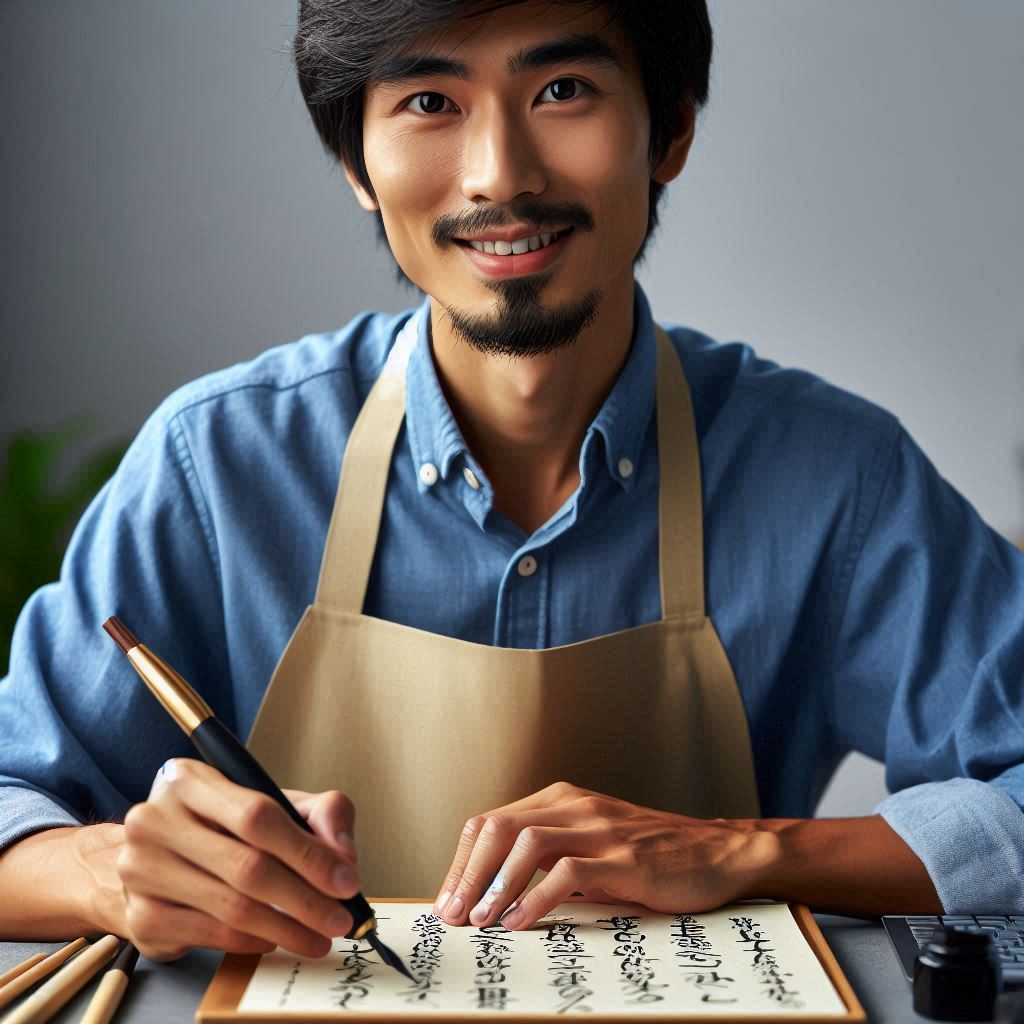Introduction
Calligraphy is the art of beautiful handwriting, highly valued in numerous cultures for its aesthetic appeal.
Throughout history, calligraphy has evolved from simple scripts to intricate styles, reflecting cultural changes.
The evolution of calligraphy demonstrates the adaptability and creativity of different societies over time.
From the ancient civilizations of Egypt and Mesopotamia to the illuminated manuscripts of medieval Europe, calligraphy has served as a means of communication, artistic expression, and cultural preservation.
Ancient Calligraphy
In ancient civilizations like Egypt and China, calligraphy played a significant role in communication and art.
Overview of Calligraphy in Ancient Civilizations
Ancient Egyptians used hieroglyphics as a form of writing, consisting of intricate symbols and designs.
These hieroglyphics were often found inscribed on tombs, temples, and other sacred structures.
Chinese calligraphy, on the other hand, evolved from hieroglyphic characters into distinct brush strokes that conveyed both meaning and beauty.
Chinese characters were and continue to be an essential element of Chinese culture and art.
Materials and Tools Used in Early Calligraphy
Ancient Egyptians used reed brushes or reed pens to inscribe hieroglyphics on papyrus scrolls or stone surfaces.
Chinese calligraphers used ink sticks, ink stones, brushes made of animal hair, and rice paper to create their artistic characters.
Throughout ancient civilizations, calligraphy was not just a means of communication but also a form of artistic expression.
The intricate designs and strokes used in calligraphy showcased the talent and skill of the scribes and artists who practiced this art form.
Read: Networking Strategies for Art and Design Professionals
Medieval Calligraphy
During the Middle Ages in Europe, calligraphy underwent significant developments and transformations.
Description of Scripts
Two prominent scripts that emerged during this period were Uncial and Carolingian.
- Uncial: This script was widely used in manuscripts and was characterized by rounded, flowing letters.
- Carolingian: Developed by Charlemagne, this script was more legible and structured than Uncial.
Influence of Religion
Religion played a crucial role in shaping calligraphy during the Middle Ages.
Monks and scribes in monasteries were responsible for copying religious texts, leading to the preservation of calligraphic traditions.
The illuminated manuscripts created during this time showcased intricate calligraphic designs, often featuring biblical stories and religious symbols.
Overall, the Medieval period in Europe saw the rise of calligraphy as a revered art form closely intertwined with religious practices and cultural expression.
Transform Your Career Today
Unlock a personalized career strategy that drives real results. Get tailored advice and a roadmap designed just for you.
Start NowRenaissance Calligraphy
Exploration of calligraphy in the Renaissance period
In the Renaissance period, calligraphy underwent significant exploration and development.
Artists and scholars alike delved into various calligraphic styles, pushing the boundaries of the art form.
Introduction of Copperplate script and its popularity
One of the most notable scripts to emerge during this time was the Copperplate script.
The Copperplate script featured intricate loops and flourishes, making it highly popular among calligraphers.
Its elegance and fluidity captured the essence of the Renaissance era’s focus on beauty and sophistication.
Additionally, calligraphy played a crucial role in the rise of the printing press during this period.
Scribes meticulously transcribed manuscripts, contributing to the dissemination of knowledge and culture.
Connection between calligraphy and the rise of printing press
The connection between calligraphy and the printing press highlighted the importance of written communication.
Calligraphers were instrumental in ensuring the accuracy and legibility of printed materials, shaping the development of typography.
Overall, the Renaissance period was a time of great innovation and creativity in the world of calligraphy.
Read: Tattoo Studios: Creating a Welcoming Environment
Modern Calligraphy
Shift towards more decorative and expressive styles in the 19th and 20th centuries
In the 19th and 20th centuries, calligraphy experienced a significant shift towards decorative and expressive styles.
Artists began to move away from traditional scripts, seeking new ways to showcase creativity.
This transformation marked a departure from purely functional writing to an exploration of aesthetics.
Rise of calligraphy as a form of art and personal expression
During this period, calligraphy emerged as a legitimate form of art.
No longer confined to manuscripts, calligraphers started to incorporate their unique styles into various mediums.
Artists used vibrant colors, intricate designs, and elaborate flourishes to create visually stunning pieces.
This new approach attracted attention and appreciation from both the public and art critics.
Influence of famous calligraphers such as Edward Johnston and Hermann Zapf
Famous calligraphers like Edward Johnston played a crucial role in this evolution.
Johnston’s work emphasized clarity and beauty in lettering.
Transform Your Career Today
Unlock a personalized career strategy that drives real results. Get tailored advice and a roadmap designed just for you.
Start NowHe is often credited with creating the modern italic style, which blends traditional techniques with contemporary flair.
His influential book, “Writing & Illuminating & Lettering,” inspired many artists to explore calligraphy as an art form.
Hermann Zapf also significantly impacted modern calligraphy.
His innovative typefaces, such as Palatino and Zapfino, showcased the elegance of handwritten letters.
Zapf‘s approach merged calligraphy with typography, highlighting the importance of letterforms in visual communication.
He demonstrated that calligraphy could be both artistic and functional.
The rise of modern calligraphy fostered a community of enthusiasts and artists.
Workshops and classes flourished, allowing people to learn and experiment with this expressive medium.
Social media further amplified this trend, enabling artists to share their work globally.
As a result, modern calligraphy continues to thrive as a vibrant form of personal expression and creativity.
Read: Tips for Finding Inspiration as a Calligrapher

Digital Calligraphy
Impact of Technology on the Practice of Calligraphy
Technology has had a significant impact on how calligraphy is practiced and created in the modern world.
With the introduction of digital tools and software, calligraphers now have new ways to express themselves and create intricate designs.
Introduction of Digital Tools and Software for Creating Calligraphy
Digital calligraphy tools and software have made it easier for calligraphers to create beautiful and intricate designs.
With the use of digital tablets and styluses, calligraphers can now create digital calligraphy with precision and ease.
Debate Over Authenticity and Skill in Digital Calligraphy
There is an ongoing debate in the calligraphy community about the authenticity and skill involved in digital calligraphy.
Some traditional calligraphers argue that digital calligraphy lacks the same level of precision and skill as traditional methods.
Digital calligraphy allows for greater experimentation and creativity.
It can be more accessible and cost-effective compared to traditional calligraphy tools.
Some argue that digital calligraphy lacks the personal touch and skill of traditional methods.
Transform Your Career Today
Unlock a personalized career strategy that drives real results. Get tailored advice and a roadmap designed just for you.
Start NowRead: Tattoo Conventions: Networking and Learning Events
Contemporary Calligraphy Trends
Current trends in calligraphy include brush lettering and modern calligraphy.
These styles have gained popularity due to their unique and artistic appeal.
Brush Lettering
Brush lettering is a modern form of calligraphy that involves the use of a brush or brush pen to create letters.
This technique allows for more expressive and fluid strokes, resulting in a lively and dynamic look.
Modern Calligraphy
Modern calligraphy is a contemporary take on traditional calligraphy styles.
It often combines elements of traditional calligraphy with more modern and creative approaches, resulting in a fresh and innovative look.
Diverse Styles and Techniques
Contemporary calligraphers are constantly exploring diverse styles and techniques to push the boundaries of traditional calligraphy.
This experimentation leads to the creation of unique and innovative pieces that appeal to a wide range of audiences.
Influence of Social Media
Social media has played a significant role in the popularity of calligraphy in recent years.
Platforms like Instagram and Pinterest have provided a space for calligraphers to showcase their work and connect with a global audience, leading to the increased visibility and appreciation of calligraphy as an art form.
In a nutshell, contemporary calligraphy trends are characterized by the exploration of diverse styles and techniques, influenced by social media platforms, and driven by a growing interest in brush lettering and modern calligraphy.
You Might Also Like: Fashion Design Specializations Explained
Conclusion
Throughout history, calligraphy has evolved from simple markings on cave walls to intricate scripts used in religious texts and artistic expressions.
From the hieroglyphs of ancient Egypt to the elegant Chinese characters, calligraphy has transcended cultures and time periods, adapting to reflect the values and aesthetics of each society.
In the modern world, calligraphy continues to captivate and inspire people with its beauty and grace, even in the digital age where handwritten letters are scarce.
The enduring appeal of calligraphy lies in its ability to convey emotions and messages in a way that no other form of communication can.
It serves as a bridge between the past and the present, connecting us to our ancestors and the traditions that have shaped our world.
As we look back on the evolution of calligraphy, we are reminded of the power of art and language to transcend barriers and speak to the human soul.
Calligraphy remains relevant in the modern world, not just as a decorative art form, but as a means of personal expression and connection in a fast-paced, digital society.
Transform Your Career Today
Unlock a personalized career strategy that drives real results. Get tailored advice and a roadmap designed just for you.
Start NowIt challenges us to slow down, appreciate the beauty of handwritten words, and find a deeper connection to the written word and the world around us.
In a world inundated with quick texts and emails, calligraphy offers a timeless reminder of the importance of thoughtful communication, creativity, and the enduring power of human expression.




